Easy Avocado Mayonnaise
This easy Avocado Mayonnaise recipe utilizes the foolproof immersion blender method to whip avocado oil and a few other simple ingredients into thick and creamy homemade mayo – perfect for sandwiches, dips, and dressings. Makes about 20 tablespoon-size servings.
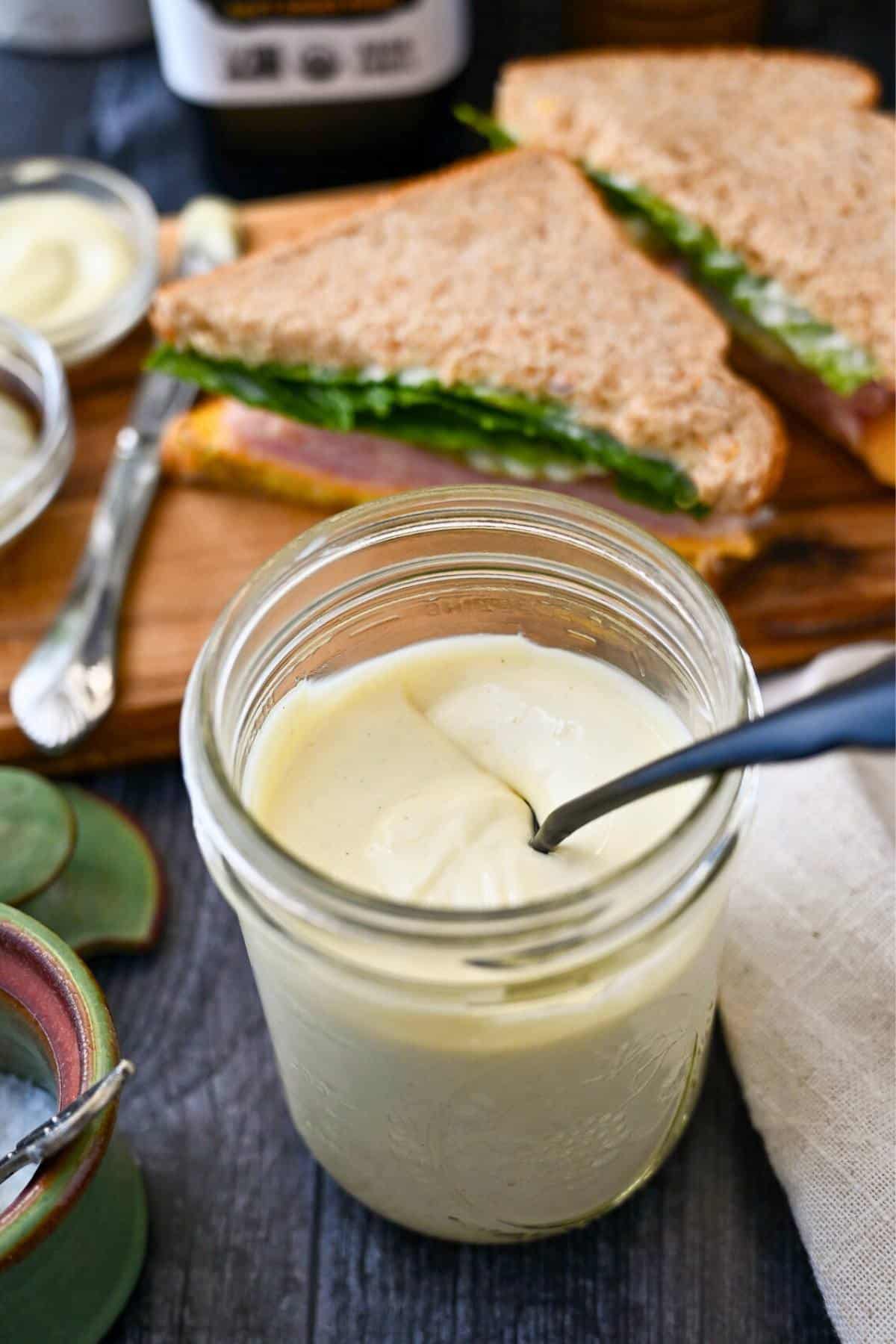
Making avocado oil mayonnaise from scratch may seem intimidating, but once you get it just right, there’s no going back. Sure, there are plenty of convenient store-bought options, but nothing compares to whipping up a batch with your own hands – especially when it tastes better than anything on the shelf.
After more failed attempts than I’d like to admit, I can hardly put into words how thrilled I was when I finally nailed this recipe. The best fix for all my mayo misery? Swapping my food processor for the Serious Eats 2-Minute Immersion Blender method, which delivers perfectly thick, creamy, foolproof mayo every single time. You can still use a food processor, but honestly, with an immersion blender, it’s almost impossible to mess up. This is the one I use regularly and love it.
And when it comes to the ingredients, I’ve always loved making mayo with olive oil, but avocado oil has become my go-to. It still offers a heart-healthy source of fat, but with an incredibly mild, neutral flavor that lets the lemon, vinegar, and seasonings shine. That said, both oils work beautifully in this recipe. Now go have fun making avocado mayo for all your favorite recipes – chicken salad, potato salad, dips, dressings, you name it!
Why you’ll love it
- Wholesome ingredients. Made with only egg, acid, a few spices, and avocado oil, this mayo is free of preservatives and sugar, which means it fits perfectly into a variety of healthy eating plans (keto, paleo, and Whole30!)
- Perfect mayo texture. Thanks to the reliability of an immersion blender, you get thick, creamy, stable mayonnaise every time, which is much more cost-effective than countless failed batches.
- Versatile and customizable. Perfect for sandwiches, dips, dressings, slaws, and even as a base for aioli or flavored sauces. Plus, the flavor possibilities are limited only by your taste buds.
Ingredients you’ll need
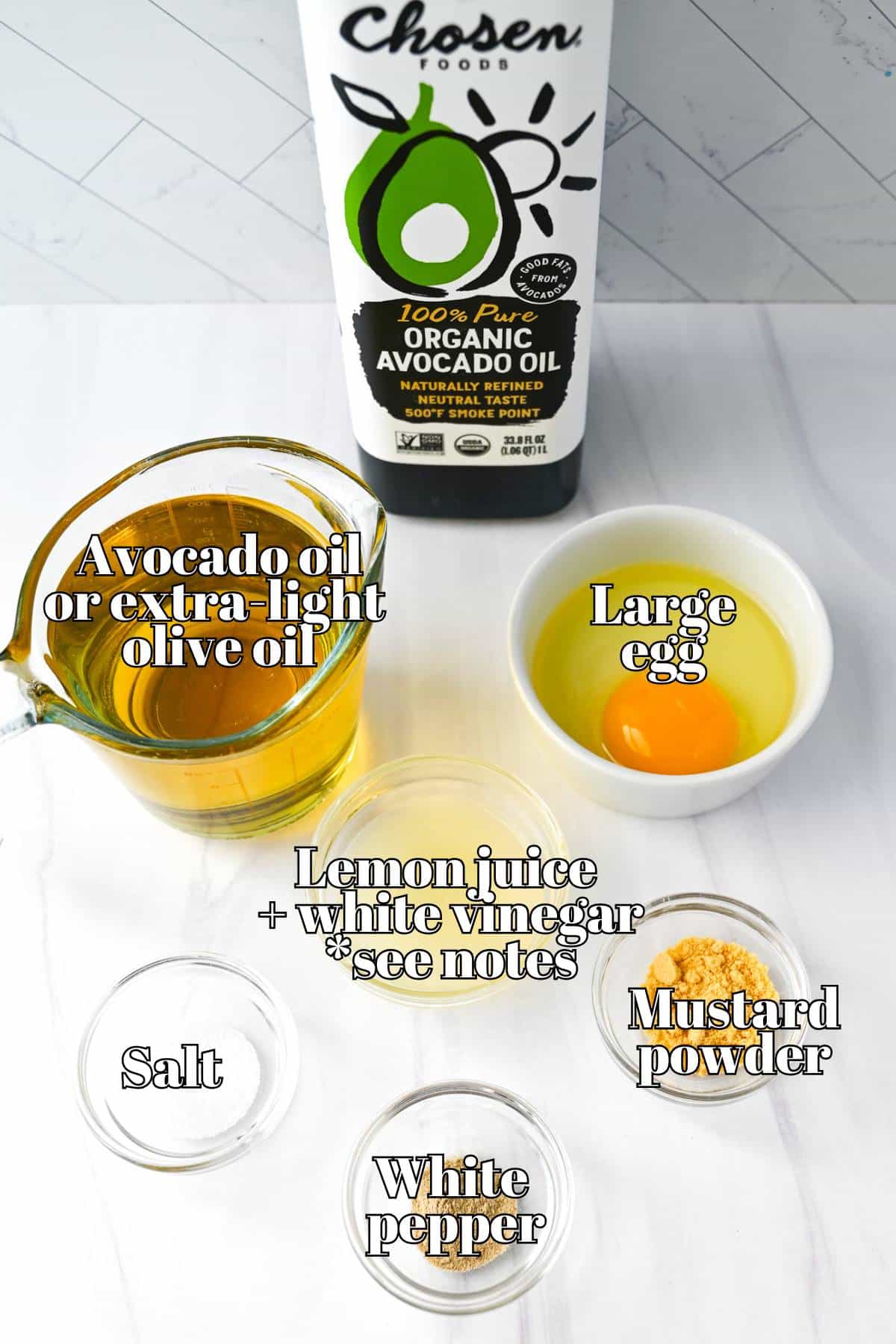
- Egg. The lecithin in egg yolks acts as an emulsifier, binding the oil and acidic ingredients into a thick, creamy mayonnaise. Using a room-temperature egg is really important here. A cold egg won’t emulsify the same way and can make the mayo runny. I also prefer using pasteurized eggs since the recipe isn’t cooked.
- Lemon Juice + White Vinegar. You need a bit of acidity to stabilize the emulsion and balance the richness of the oil. I like using a mix of lemon juice and white vinegar. The vinegar adds a distinct tang that makes it taste closer to our favorite Southern mayo brand, but all lemon juice works too. Regardless, stick with fresh-squeezed lemon juice here. The bottled stuff won’t give your mayo the clean finish it deserves.
- Seasonings. Mustard powder adds subtle warmth and helps strengthen the emulsion (don’t skip it!), while white pepper keeps the flavor clean and delicate without the speckles you’d get from black pepper.
- Avocado Oil. I prefer making mayo with avocado oil for its neutral flavor and consistency. Chosen Foods is my favorite brand. However, extra-light olive oil or a blend of light olive oil and avocado oil (which some readers have achieved great results with) works just as well. Just avoid extra-virgin olive oil. It’s too assertive and can taste bitter in mayo.
- Kosher Salt. Seasoning with salt at the end lets you fine-tune the flavor. Start with a ¼ teaspoon and adjust to taste. We like our mayo on the saltier side, so I use a full teaspoon.
One more quick ingredient note: Using room-temperature ingredients makes all the difference. Cold ingredients can prevent the emulsion from forming. If your egg is chilled, place it in lukewarm water for 5-10 minutes before starting.
How to make mayonnaise with avocado oil
I’ve made homemade mayo in a food processor for years, but once I tested the immersion blender method, I was completely converted. The food processor technique still works, but it definitely has a larger margin for error. If you don’t have an immersion blender, don’t worry – I’ve included the food processor instructions, too.
How to make it with an immersion blender

Step 1: Build the base. Add the egg, lemon juice, vinegar, mustard powder, and white pepper to the bottom of the immersion-blender jar or any tall, narrow container that fits your blender head.
Step 2: Layer the oil. Gently pour the avocado oil over the mixture, and let it settle for 15 to 20 seconds – this separation helps the emulsion take hold instantly.
Step 3: Emulsify. Place the immersion blender head at the bottom of the jar and blend on high without moving the blender at first – no pulsing! Once the bottom thickens and turns creamy, slowly lift and tilt the blender to incorporate the remaining oil.
Step 4: Season and store. Taste and season with salt to your liking, then transfer the mayo to an airtight container and store in the refrigerator.
How to make it with a food processor
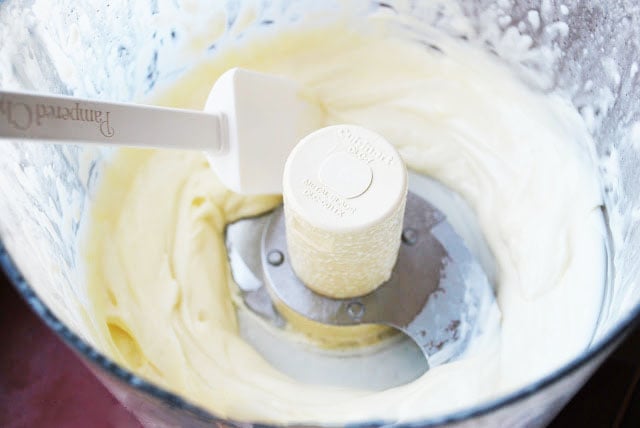
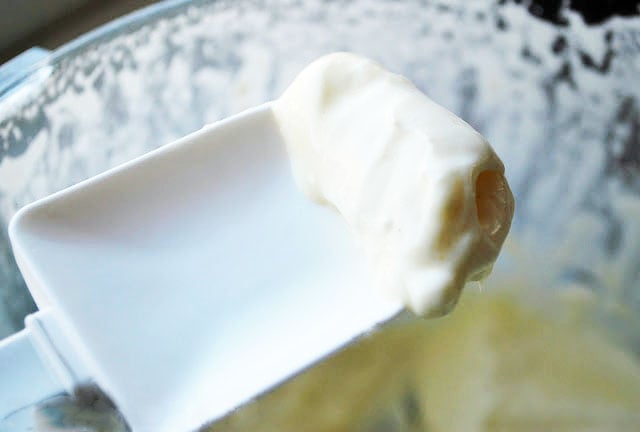
Step 1: Aerate the base. Add the egg, lemon juice, mustard powder, white pepper, and salt to the food processor, and blend until the mixture is frothy.
Step 2: Begin the emulsion. Using the drip hole on the lid, add the oil a few drops at a time. Don’t rush this step! Adding the oil too fast will break the emulsion and leave you with a liquid-y mess.
Step 3: Stream the oil. Once some of the oil has incorporated successfully, VERY slowly drizzle the remaining oil down the feed tube (I’m talking glacially slow). Continue blending until the mayo is thick, creamy, and fully emulsified.
Recipe tips and FAQs
- Choose the right container. If using an immersion blender, you need a jar that’s just slightly wider than the blender head so the egg and acid mixture makes full contact with the blades from the very start. If your container is too wide, try doubling the recipe, so the liquid comes up higher around the blade.
- Blend undisturbed at first. You want to keep the immersion blender planted firmly at the bottom, then after about 10-15 seconds, once the base is thick and creamy, you can slowly lift the blender to draw in the remaining oil. This is key to creating a thick mayo that won’t separate.
- Pour oil painfully slowly. If you’re using a food processor, when I say go “slow” with the oil, I mean at the slowest pace possible. If you think you’re going slow enough, slow down even more. Pouring too quickly is the number one reason mayonnaise breaks when using this method.
- Switch up the flavor. I previously used all lemon juice (2 tbsp) instead of the blend of vinegar and lemon. We prefer the flavor profile of the lemon vinegar mix, but feel free to use all fresh lemon juice or more or less vinegar to adjust to your taste preference. Just make sure that the acid blend you use equals 2 tablespoons in total.
Flavor variations
Once you’ve mastered the basic avocado mayonnaise recipe, don’t be afraid to have fun with flavor. Here are a few ideas:
- Garlic mayo: Blend a few roasted garlic cloves (not fresh) for a rich, savory flavor.
- Spicy mayo: Stir in sriracha or your favorite hot sauce to taste.
- Herbed mayo: Blend in a handful of finely chopped fresh herbs, such as basil, dill, chives, tarragon, or parsley.
- Bacon mayo: Mix in finely crumbled, crispy bacon for a creamy, smoky condiment perfect for sandwiches or burgers!
Absolutely! You can use extra-light olive oil or even a blend of light olive oil and avocado oil. If you choose this route, do NOT use extra-virgin olive oil. I can’t emphasize this enough: EVOO will make your mayo taste terrible. Stick to the extra-light or light-tasting cheap stuff. Trust me.
Technically, yes, you can make homemade mayo with unpasteurized eggs, but the USDA advises using pasteurized eggs to reduce the risk of bacteria like Salmonella. If you use unpasteurized eggs, do so at your own risk. There are sous vide methods that allow you to pasteurize whole eggs at home, but I haven’t tried it yet.
If your mayo comes out thin or runny, it means the emulsion didn’t form completely, but don’t panic. You should be able to “rescue” it by letting the mixture rest until it separates slightly, then blend it again until stable. At this point, if it still won’t thicken, your best bet is to start over with a clean jar and new ingredients.
Storing
Fridge: Refrigerate your avocado mayo in a clean, airtight jar or container. If you used unpasteurized eggs, I wouldn’t risk keeping it longer than 5 days. If made with pasteurized eggs, the mayo can last in the fridge for up to 2 weeks, but always use your best judgment and discard if it looks or smells off.
Freezing: I don’t recommend freezing this mayo. The emulsion won’t survive, leaving it separated and runny once thawed.
More easy homemade condiment recipes
If you love this recipe for homemade mayonnaise with avocado oil, I would be so grateful if you could leave a 5-star 🌟 rating in the recipe card below. I love reading your comments and feedback!
Stay posted on my latest cooking adventures through social media @ Instagram, Pinterest, and Facebook. Also, don’t forget to tag me when you try one of my recipes!
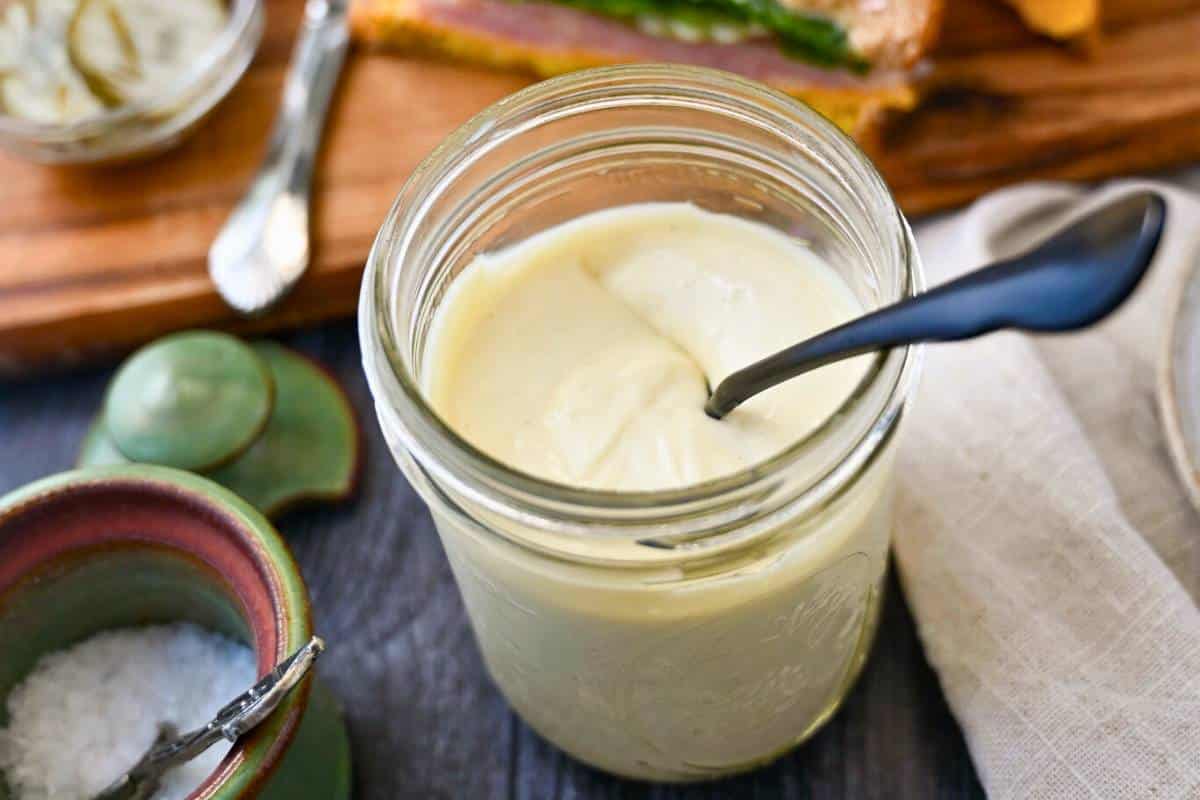
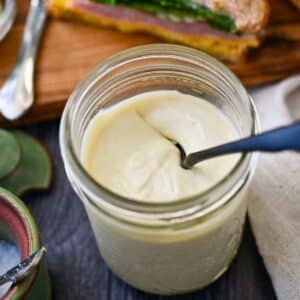
Avocado Mayonnaise
Ingredients
- 1 large egg room temperature (very important!!) also use a pasteurized egg for food safety
- 1 tbsp fresh squeezed lemon juice (do not use bottled lemon juice here)
- 1 tbsp white vinegar
- ½ tsp mustard powder
- ¼ tsp white pepper
- 1 cup avocado oil
- ½-1 tsp kosher salt *I use a teaspoon- but we like it salty
Instructions
Immersion Blender Method (easiest):
- Add the egg, lemon juice, vinegar, mustard powder, and white pepper to the bottom of the immersion-blender jar or any tall, narrow container that fits your blender head with a little extra room on the sides.
- Gently pour the avocado oil over the mixture, and let it settle for 15 to 20 seconds – this separation helps the emulsion take hold instantly.
- Place the immersion blender head at the bottom of the jar and blend on high without moving the blender at first – no pulsing! Once the bottom thickens and turns creamy, slowly lift and tilt the blender to incorporate the remaining oil.
- Taste and season with salt to your liking, then transfer the mayo to an airtight container and store in the refrigerator.
Food Processor Method:
- Combine egg, lemon juice, vinegar, mustard powder, white pepper, and salt in the food processor and blend until frothy.
- Using the drip hole in the top of the processor, drizzle the oil in a few drops at a time (do not rush this emulsion process…it will result in a liquid mess)
- Once you have a good bit of drops mixed in, very slowly (I cannot over emphasize VERY SLOWLY) drizzle the oil down the tube little by little until all is mixed in and the mayo is nice and creamy.
Notes
- Makes about 20 tablespoon-size servings
- I prefer making mayo with avocado oil for its neutral flavor and consistency. Chosen Foods is my favorite brand. However, extra-light olive oil or a blend of light olive oil and avocado oil (which some readers have achieved great results with) works just as well. Just avoid extra-virgin olive oil. It’s too assertive and can taste bitter in mayo.
Nutrition
- Southern Healthy Fried Chicken - November 10, 2025
- Ground Beef Breakfast Casserole - November 5, 2025
- Creamy Paprika Chicken Skillet - October 20, 2025

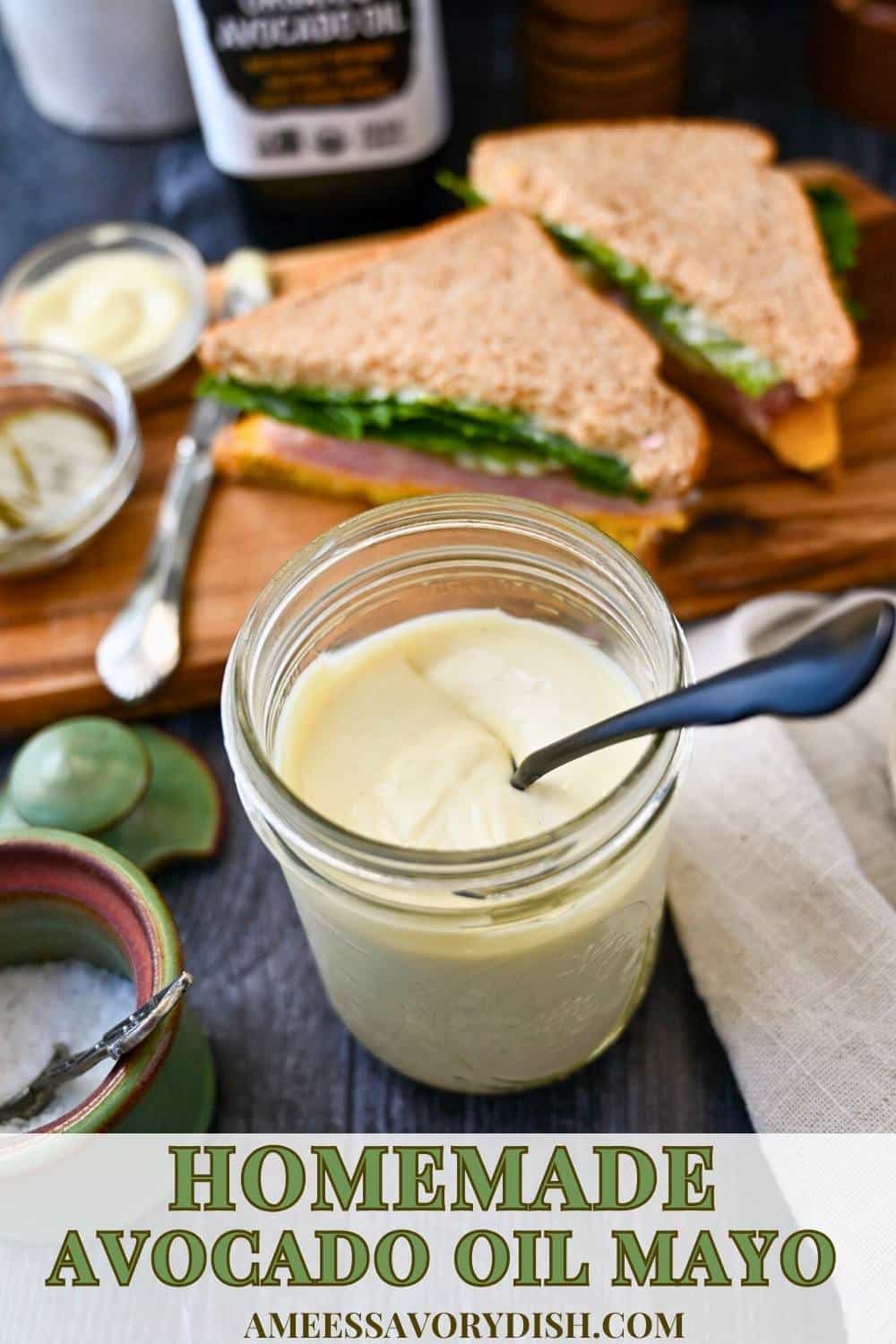
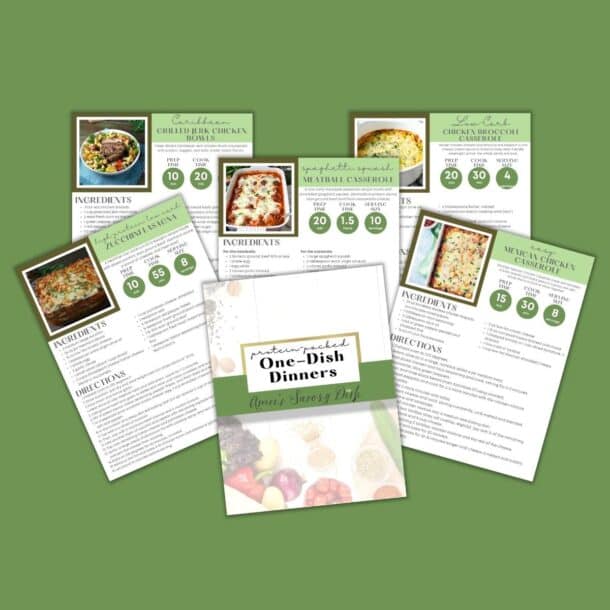
This worked PERFECT for us. We didn’t have white pepper but just used black and let it have flecks – ultimately it’s going in chicken salads and what not anyway so I figured why not? THANK YOU – great recipe!
I use a mixture of 1/2 avocado oil and 1/2 EVOO…its wonderful!
Are you using the whole egg or just the yolk?
Use the whole egg 🙂
I sub 1/2 the olive oil for coconut oil and I do use the hand blender and it works perfectly. I’ve NEVER had a problem with it ‘solidifying’ either. I’ve tried the FP method and have never been able to get it to turn out. Glad it worked for you.
The flavor of coconut oil wouldn’t work well at all in this mayo. Also, it gets solidified at room temperature, so it wouldn’t be the right texture either. It’s great for so many other things, though! I love coconut oil!! 😉
Do you think coconut oil would work?
Thanks for the great explanation Beth! The food processor is so much easier than the blender!!
I made one successful batch out of 4 with a blender. Will try the food processor next.
Actually, with a food processor, it is not SO important to drizzle the oil in such a thin stream. James Beard clued me in to this fact. The emulsionn will not break in a food processor with a faster pour of oil.
Re EVOO … when made by machine, the oil will release a strong rather bitter flavor. You can use EVOO if making the mayo by hand, but virgin or light olive oil will give much better results when making in a high speed processor or blender.
Thank you for the recipe!!! Ahh awesome! You’re amazing!
Colie you are most welcome!! Thank you for the sweet comment and let me know how the mayo turns out. 🙂
Thank you Colie! Avocado oil would be a great substitution. I haven’t tried it yet, but I think I will. 🙂
Great blog!! What would you suggest instead of light olive oil? I don’t like using any oils that have been processed and refined taking out nutrients..
Maria, you can use a stick blender or a whisk and do it by hand, but it’s much easier with a food processor. I didn’t have much luck with the blender method.
What do you suggest if you don’t have a food processor?
Is there a way to make an egg free mayo?
I had the same problem with A LOT of mayo recipes that I tried, so you’re not alone! I tinkered with this recipe until I got it just right, so I hope you find great success with this version. 🙂
Thanks for posting this recipe. I’ve tried making mayo and the best I can get is a thinner version of an aioli, but I’ve been using a blender. I’m going to give this a whirl!! I ‘ll let you know how it turns out. I think everyone should wash the outside of their egg really well first. Just to be safer!
I think I might try this!
This will keep for 1-2 weeks in the fridge in a sealed container.
How long is it good for?
How how long will this last in the fridge?
THANK YOU!!!!!!!
Melissa, I tried it with EVOO just to see how it would work and it’s too thick and the flavor is too strong. You need an extra light oil with very little flavor to make good mayo. 🙂
Just curious…..why not EVOO? will it not turn out?